|
Further Investigation: Knock-Out Lab
Purpose:
To see how the different strains of halo would respond to the different concentrations of metal (CuSO4 and ZnSO4) in CM.
Protocol:
The same protocol was used for both The Metal Toxicity Lab and the KO Lab; however, the metals copper and zinc were used instead of iron and nickel. Also, instead of using the Halo strain NRC-1, three different knock out strains were used. The URA3 strain has the URA3 gene knocked out. This strain is unable to synthesize uracil and thus replicates at a slower rate than the NRC-1 strain. The URA3 strain was used as the parent strain to make the other knock out strains.
The 0700G strain had the yvgx gene knocked out. The protein coded by the yvgx gene pumps out copper when the metal is present in high concentrations. This pump is a vital part of xenobiotic metabolism, the metabolism of compounds foreign to an organismís original biochemistry.
The 1179c strain had the 1179c gene knocked out. The 1179c gene codes for a protein that regulates the yvgx protein.
Our hypothesis is that 1179C doesn't direcly regulate the ZnSO4 efflux pump.
These three strains were placed in different concentrations of copper and zinc.
Results:
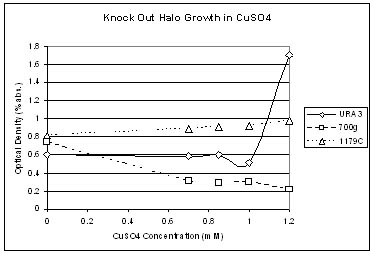
As seen in the graph above, the URA3 had the most growth out of the three strands of Halo in the CuSO4 solutions, and grew the most at a 1.2 mM concentration of CuSO4. 1179C had minimal growth in CuSO4, and 700g died in CuSO4.
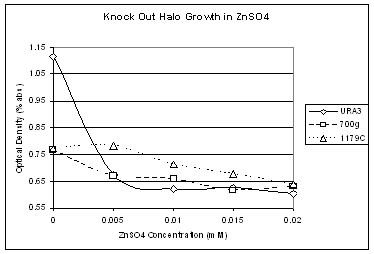
As seen in the graph above, 1179C began to grow in the ZnSO4 solution at a ZnSO4 concentration betweem 0 and .005 mM, but began to die when the ZnSO4 concentration exceeded .005. Both URA3 and 700g began to die as soon as the ZnSO4 conentration exceeded 0 mM.
Further Trials:
This experiment was repeated using a well plate.

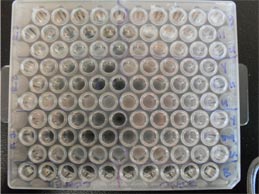
Results:
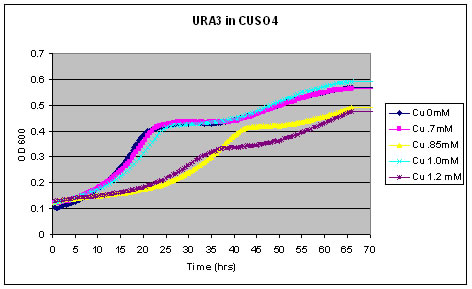
From the graph above, it can be inferred that URA3 grew better in the 1.0mM concentration of CuSO4 than the other concentrations because URA3 reached it's highest optical density (OD) at that concentration.

However, in ZnSO4, URA3 grew best in a .005 mM concentration.
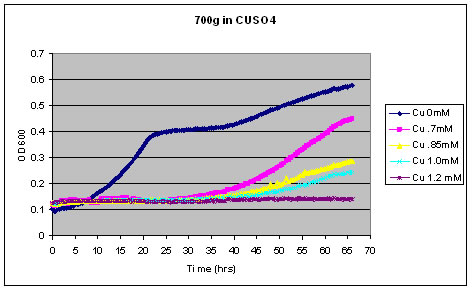
The knock-out strain VNG 0700G grew the most in a CuSO4 concentration of 0mM and the amount of growth continued to decline as the concentration of CuSO4 increased. Perhaps this is due to the fact that the yvgx gene which is knocked out in this strain controls an efflux pump that takes copper out of the halo cells when the CuSO4 reaches a certain concentration.

The knock-out strain 0700G grew the most in a .005 mM and .015 mM concentration of ZnSO4. Perhaps this is because the efflux pump is specific to Cu, so the halo should not have any problems growing in Zn if that the gene 1179C that regulates that pump is knocked out.

The knock-out strain 1179C grew the best in a 0mM concentration of CuSO4, and the growth rate continued to decline as the concentration of CuSO4 increased. Perhaps this is because the gene 1179C regulates the gene yvgx that controls the efflux pump, so the halo began to die because it could not pump the CuSO4 out of the cell.

1179C grew the best in a .005 mM concentration of ZnSO4. Once again, perhaps this is because the efflux pump is specific to Cu, so the halo should not have any problems growing in Zn if 1179C is knocked out.
[back to top]
|





